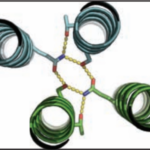Over the course of billions of years, nature has evolved particular molecular structures that form the basis of life, such as those found in nucleic acids and proteins. Using the natural form as a springboard, University of Washington researchers have designed protein homo-oligomers, or identical interacting subunits, which can contain interchangeable hydrogen bonding modules for building different structures or functions. The team of researchers, led by David Baker at the University of Washington, included Jose Henrique Pereira, Banumathi Sankaran, and Peter Zwart of the Molecular Biophysics & Integrated Bioimaging Division (MBIB).
Biosciences Area FY16 LDRD Projects
The projects of eleven Biosciences Area scientists and engineers received funding through the FY2016 Laboratory Directed Research and Development (LDRD) program. These projects cover a broad range of topics, including energy science technology applications, novel computing technologies, and mechanistic understanding of multi-scale interactions among molecules, microbes, plants, metazoans, the abiotic environment, and their feedbacks. Together, these efforts account for nearly 14% of the $25.3 million allocated. Lab-wide, 84 proposals were selected from a field of 179.
Big Moves in Protein Structure Prediction and Design
The potential of modular design for brand new proteins that do not yet exist in the natural world are the latest in a recent series of developments toward custom-designing proteins. Scientists with the University of Washington used the Berkeley Lab Advanced Light Source (ALS) for some of their research. They collaborated with Susan Tsutakawa , Greg Hura, and Kathryn Burnett, of the Molecular Biophysics & Integrated Bioimaging Division, who work at the ALS beamline SIBYLS where some crystallography studies of repeat protein molecule structures took place.
- « Previous Page
- 1
- …
- 3
- 4
- 5
Was this page useful?






